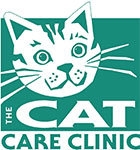I had a very nice client named Peggy at my clinic on Monday. She had found a very friendly and outgoing male cat in the unincorporated area of Santa Ana about six months earlier, and she wanted to be sure that he was vaccinated and healthy. It was the first time that she had taken him to a vet. Peggy told me that she was really enjoying the cat and that he was a lot of fun to have around.
The first thing I did when I started his examination was to scan him for a microchip. What do you know? He had a chip. This of course was surprising news to Peggy. I told her that we should trace the chip and find out if the cat still had an owner that wanted him. She was disappointed to find out that there was another owner, since she liked the cat so much. I told her that although she wanted the cat, if she had been the one who had lost him, she would be thrilled to find out that he was still alive and get him back.
My front office manager called and found a contact number for the original owner. She called him and he said that the cat was given to his son’s girlfriend, Donna, about two years ago but he had gotten out about six months ago. He said he would contact her and get back to us. Donna was extremely happy to find out that her lost “Figaro” was found. She drove down from El Monte later that morning and met up with Peggy at our clinic. It was a great reunion between Donna and Figaro.
Usually when cats get lost in Orange County, owners fear that they have been eaten by coyotes. Fortunately for Figaro, he was found by a caring woman and able to be reunited with his owner because of his microchip. How did Figaro get from El Monte to Tustin? We don’t know the whole story.
This isn’t the first time that we have helped get a lost cat back to his owner. At my clinic, we scan every found cat for a chip. Unfortunately, only a small percentage of cats have microchips. We recommend that every cat get a microchip. Most of the cats that get lost are indoor exclusive cats that get out by accident or during an emergency or disaster. I tell owners that microchips are like getting an extra insurance policy on their cat. A microchip is not a guarantee that a cat will be recovered, but it is a way to permanently identify your cat and try to get him back.
All of the animal shelters in Orange County are supposed to scan any animals that they find at least once, if not several times. I hope that all veterinary clinics are doing the same. Many rescue groups and adoption centers place a microchip in all of the pets that go to new homes.
It takes a few seconds to have a microchip placed under the skin of your pet. It is no more painful that any other injection and doesn’t hurt afterwards. The chip is made of inert materials and carries a unique identification number that can be scanned. It is not a transmitter.
If your cat doesn’t have a microchip, think about getting one. A microchip could be the difference between recovering a pet that has accidently gotten outside and never seeing that loved cat again.
Written by Dr. Wexler-Mitchell of The Cat Care Clinic in Orange, CA
Copyright © 2011 The Cat Care Clinic
